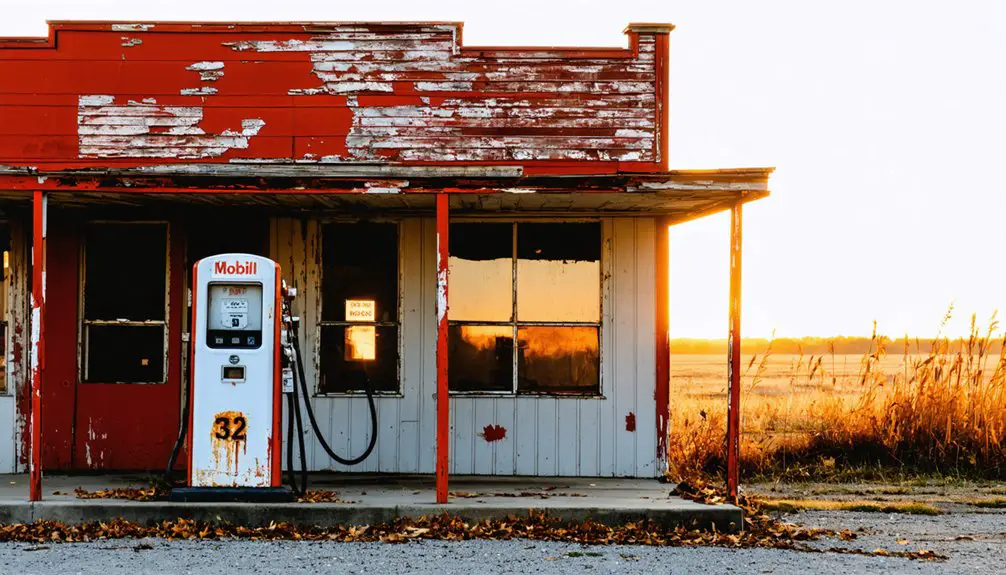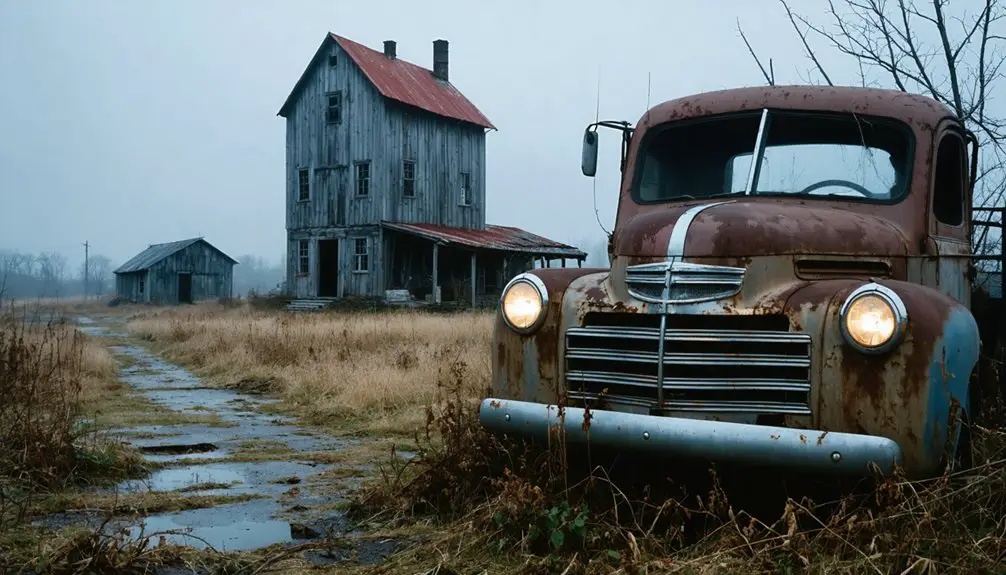You’ll find the ghost town of Aral tucked within Michigan’s Sleeping Bear Dunes National Lakeshore, where a bustling lumber settlement once thrived in the 1880s. Founded by surveyor Orange Risdon and later developed by Civil War photographer Robert Bancroft, this coastal community peaked at 200 residents before surrendering to nature by 1922. While no original structures remain at today’s Esch Beach, the stories of immigrant laborers, innovative logging operations, and pioneer resilience linger in the pristine landscape.
Key Takeaways
- Aral was a 19th-century lumber settlement along Lake Michigan that peaked at 200 residents before becoming a ghost town.
- The town’s remains are now part of Sleeping Bear Dunes National Lakeshore, with Esch Beach occupying its former location.
- Founded in 1853 by Orange Risdon, Aral thrived on lumber operations until declining after the Bancroft family’s departure in 1922.
- No original structures remain, but the site features interpretive signage explaining the ghost town’s history to visitors.
- The town supported a diverse community of Yankees, European immigrants, and lumber workers before surrendering to nature.
The Birth of a Logging Settlement
A pristine wilderness along Lake Michigan’s eastern shore would soon transform into a bustling lumber settlement called Aral.
You can trace its beginnings to 1853, when surveyor Orange Risdon first laid eyes on the mouth of Otter Creek. Captivated by the area’s potential, he and his wife Sally quickly secured 122 acres through land acquisition. The name was inspired by the Aral Sea in Central Asia.
The property changed hands to Robert F. Bancroft, a Civil War photographer who carved out 20 acres, built a log cabin, and planted black locust trees. Land speculators rushed to acquire parcels for just seventy-five cents per acre.
But it wasn’t until lumber speculators discovered the rich stands of white pine that Aral’s destiny was sealed. By 1881, Dr. Arthur O’Leary had launched extensive logging operations, complete with a sawmill, millpond, and shipping dock – transforming this quiet settlement into a thriving lumber town.
Life in Michigan’s Northern Frontier
You’d find pioneer life in Michigan’s northern frontier filled with stark challenges, from bitter winters that tested even the hardiest settlers to the constant struggle of wresting sustenance from thin, sandy soils.
Your survival would’ve depended on adapting to a lifestyle quite different from traditional farming, relying instead on hunting, fishing, and seasonal work in the bustling lumber camps. Ancient stone structures known as V-shaped boulder blinds offered prime spots for hunting, a tradition dating back to early Native American hunters.
Whether you were a Yankee from New England, a European immigrant, or a seasonal worker drawn by resource booms, you’d have joined a diverse frontier community where shared hardships often transcended cultural differences. The wilderness environment demanded rapid adaptation to local conditions, transforming European settlers into distinctly American frontiersmen.
Pioneer Hardships and Survival
Life in Michigan’s northern frontier during the mid-19th century tested even the hardiest pioneers, who faced a perfect storm of challenges that would’ve broken less determined souls.
You’d have found yourself battling thin, sandy soil that barely supported crops, while the short growing seasons left little room for error in your farming efforts.
Pioneer resilience meant developing survival strategies that went beyond traditional agriculture – you’d have needed to master fishing in the abundant lakes, work in the burgeoning timber camps, or seek fortune in the copper mines of the Upper Peninsula. Following the path of Yankee settlers, many families migrated westward from New England due to poor farming conditions in their home regions. By 1850, most settlers avoided the harsh northern regions, with 98 percent residing in Michigan’s more hospitable southern counties.
Winter’s isolation meant you couldn’t count on outside help, forcing you to become remarkably self-reliant.
With limited infrastructure and sparse settlement, you’d have learned to adapt quickly or risk becoming another failed frontier statistic.
Cultural Melting Pot Settlement
Northern Michigan’s cultural landscape emerged mainly from New England roots, painting a less diverse portrait than you might expect from a frontier region.
If you’d ventured into these settlements in the 1830s, you’d have found yourself among Yankees – descendants of English Puritans who brought their distinct traditions with them.
Unlike other frontier regions, immigrant integration happened slowly here, with many European newcomers choosing to settle elsewhere. The thin, sandy northern soil deterred many potential settlers from establishing farms in the region.
Yet, the area’s economic activities fostered unique cultural exchange opportunities:
- Logging camps drew diverse laborers together, creating unexpected melting pots
- Mining communities attracted fortune-seekers from various backgrounds
- Great Lakes trade routes connected isolated settlements to broader cultural influences
The result? A distinctive hybrid culture emerged, blending New England traditions with frontier practicality and resourcefulness.
The Rise of the Lumber Empire
As Michigan’s accessible timber supplies near Grand Haven dwindled in the mid-1800s, lumber speculators turned their attention to the pristine forests surrounding Otter Lake, giving birth to Aral’s lumber empire.
You would’ve witnessed Dr. Arthur O’Leary, despite his limited experience, boldly establishing a two-story sawmill and supporting infrastructure by 1881. The innovative lumber techniques included steam-powered inclined ramps lifting logs from Otter Creek’s millpond to the processing floor. Workers relied on river transport methods to move logs efficiently before railroad systems were established.
The economic rivalry between Aral and Edgewater intensified by 1889, driving expansion efforts. Today, visitors can find the town’s remains within Sleeping Bear Dunes, a protected national lakeshore.
You’d have seen 150 workers in winter logging camps and 50 maintaining summer operations. Even when fire destroyed the original mill, O’Leary’s determination led to rebuilding a larger facility, cementing Aral’s position in Michigan’s competitive lumber market.
Cultural Tapestry of Early Settlers
Behind the thundering saws and bustling lumber operations, Aral’s cultural foundation took shape through the determined spirit of its diverse pioneers. You’d find immigrants from Bohemia seeking refuge from urban epidemics, Irish settlers like Dr. O’Leary bringing entrepreneurial spirit, and Civil War veterans like Bancroft establishing new roots.
Their immigrant traditions flourished as they built communal barracks and shared the harsh winters together, displaying remarkable cultural resilience. The town’s general store and church became vital community gathering places.
- Bohemian families like the Kraitz and Muzil clans fled Chicago’s typhoid outbreaks, bringing their customs to the wilderness
- Joseph Krubner’s newspaper writings captured the raw struggles and dreams of immigrant life
- Settlers created a tapestry of skills: photography, farming, logging, and surveying
Their collective determination transformed Aral from untamed forest into a thriving multicultural haven.
The Final Days of Prosperity

But by 1900, you’d sense the approaching end. The post office’s closure that year marked the beginning of final business closures throughout the settlement.
As timber resources dwindled, the sawmills – Aral’s economic heart – shut down around 1911. Community migration followed swiftly, with even the prominent Bancroft family departing by 1922.
The town that once bustled with frontier energy and lumber trade gradually surrendered to nature, leaving only memories of its prosperous days.
Modern Legacy at Sleeping Bear Dunes
When you visit Aral’s former site today, you’ll find yourself at the popular Esch Beach within Sleeping Bear Dunes National Lakeshore, where Otter Creek meets Lake Michigan’s pristine waters.
While no original structures remain from the once-bustling lumber town, you’re walking through a landscape that seamlessly blends natural beauty with historical significance.
The ghost town’s compelling story lives on through the National Lakeshore’s educational programs, making it a fascinating stop for tourists seeking both recreation and a connection to Michigan’s logging heritage.
Recreational Area Today
Although Aral’s sawmill days are long gone, this historic ghost town site now serves as a cherished recreational spot within Sleeping Bear Dunes National Lakeshore.
You’ll find a pristine swimming beach where Otter Creek meets Lake Michigan, perfect for cooling off on hot summer days. The National Park Service maintains visitor amenities including parking areas and beach access trails, though they’ve kept development minimal to preserve the natural setting.
- Swim in the calm waters where creek meets lake, a favorite spot for families
- Explore nearby hiking trails through towering dunes and along the shoreline
- Watch for native wildlife and plants while picnicking on the beach
Today, you can experience this transformed landscape where nature has reclaimed what was once a bustling lumber town, creating an ideal escape for outdoor recreation.
Historical Tourism Impact
Today’s visitors to Aral might wonder where this once-thriving lumber town actually stood, as nearly all physical traces have vanished into the natural landscape.
Yet you’ll find the ghost town’s legacy woven into the fabric of Sleeping Bear Dunes National Lakeshore’s heritage tourism experience.
While swimming at nearby Esch Beach, you can explore interpretive signage that connects you to Aral’s fascinating past.
Local museums showcase the town’s transformation from a bustling lumber settlement to a protected natural area.
You’ll discover how this remote outpost, which once supported 200 residents, has become part of a broader story about Michigan’s resource extraction history.
Though physical structures no longer remain, Aral’s compelling narrative continues to enrich visitors’ understanding of the region’s evolution from industry to conservation.
Frequently Asked Questions
Were There Any Major Fires or Disasters in Aral’s History?
You won’t find any major fire incidents or disaster impacts in historical records. The town’s decline came from economic failure rather than catastrophic events, though small, undocumented fires might’ve occurred.
What Happened to the Native American Populations in the Aral Area?
In a heartbeat, your ancestors’ world vanished. Native American history shows the Anishinaabe people lost their lands through the 1836 Treaty, facing devastating cultural displacement as logging operations and European settlements consumed their traditional territories.
How Did Mail and Supplies Reach the Isolated Settlement?
You’d find mail delivery came by horseback and boat routes, while supplies reached the settlement through Lake Michigan’s dock system and overland trails connecting to larger towns nearby.
What Were the Average Wages for Workers in Aral’s Lumber Mills?
You’d earn between $1.50-$2.00 daily in the lumber industry, working grueling 14-hour shifts. While these wages let you save for your own land, you’d endure tough economic conditions and crowded bunkhouses.
Did Any Criminal Gangs or Outlaws Operate in Aral?
You won’t find evidence of organized outlaw activities or gang presence in the historical records. While there was a pioneer shootout and one murder, these were likely isolated incidents rather than organized crime.
References
- https://glenarborsun.com/a-shootout-in-the-ghost-town-of-aral/
- https://www.youtube.com/watch?v=1KeSmsO68H8
- https://www.nps.gov/slbe/learn/historyculture/ghosttowns.htm
- https://www.nps.gov/places/000/aral-a-town-that-vanished.htm
- https://99wfmk.com/aral-michigan/
- http://betsiecurrent.com/index.php/lumberjacks-and-cracker-jacks/
- https://npshistory.com/publications/slbe/brochures/ghost-towns-2011.pdf
- https://en.wikipedia.org/wiki/History_of_Michigan
- https://www.historians.org/resource/the-significance-of-the-frontier-in-american-history/
- https://project.geo.msu.edu/geogmich/european_settlement.html



